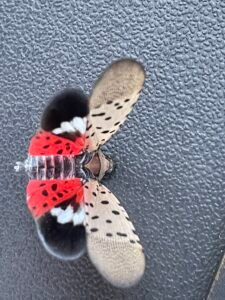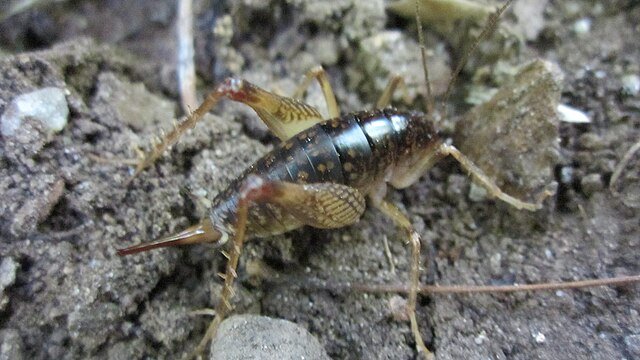Spotted Lanternfly (Lycorma delicatula): Identification, Risks, and Complete Pest Control Guide
 The spotted lanternfly (Lycorma delicatula) has become one of the most notorious invasive pests in recent decades. Native to Asia, this planthopper has spread aggressively to North America and parts of Europe, leaving behind damaged orchards, vineyards, and urban landscapes. Unlike aphids, which sap plants quietly, the spotted lanternfly gathers in huge numbers, excretes sticky honeydew, and causes visible destruction.
The spotted lanternfly (Lycorma delicatula) has become one of the most notorious invasive pests in recent decades. Native to Asia, this planthopper has spread aggressively to North America and parts of Europe, leaving behind damaged orchards, vineyards, and urban landscapes. Unlike aphids, which sap plants quietly, the spotted lanternfly gathers in huge numbers, excretes sticky honeydew, and causes visible destruction.
While the insect does not bite or sting humans, its impact on agriculture and forestry is severe. Entire wine industries, fruit tree orchards, and even ornamental trees have come under threat. For homeowners, farmers, and policymakers alike, understanding this pest is critical for developing sustainable solutions.
This article provides a deep look into the biology, risks, and management of the spotted lanternfly—covering identification, ecology, control methods, and even cultural responses to its spread.
Identification
Correct identification is the first step in controlling Lycorma delicatula.
Size: Adults are about 2.5 cm (1 inch) long and 1.25 cm (0.5 inches) wide.
Coloration: Forewings are gray with black spots, while the hindwings are bright red with black spots and white bands. This flash of red when they fly is unmistakable.
Nymphs: Younger stages (instars) are black with white spots. As they mature, they develop striking red patches before becoming adults.
Egg masses: Tan to gray waxy coatings on trees, vehicles, firewood, and outdoor furniture. They resemble dried mud or putty.
Key difference from moths or butterflies: lanternflies hold their wings tent-like over their bodies, not flat.
Biology and Ecology
The spotted lanternfly is a phloem-feeding insect, meaning it inserts its piercing-sucking mouthparts into trees and plants to consume sap.
Life Cycle:
Eggs are laid in fall.
Nymphs hatch in late spring.
Adults emerge in mid-summer, with peak activity from July to October.
Feeding: Preferred host is the tree of heaven (Ailanthus altissima), but they feed on more than 70 plant species including grapes, apples, peaches, hops, walnuts, and ornamental trees.
Honeydew production: As they feed, they excrete sugary liquid that attracts ants, wasps, and promotes growth of black sooty mold.
Lanternflies are weak fliers but strong jumpers. Their rapid spread comes primarily from humans transporting egg masses on firewood, vehicles, and outdoor goods.
Global Distribution
Native Range: China, Vietnam, and parts of India.
Invasive Spread: First detected in South Korea in 2004, Japan in 2009, and Pennsylvania, USA in 2014.
United States: Established in Pennsylvania, spreading to New Jersey, Delaware, Maryland, Virginia, New York, Connecticut, and Ohio.
Europe: Recently reported in Italy, with potential for spread across southern Europe’s vineyards.
Climate modeling suggests that Lycorma delicatula could colonize much of North America and Europe if unchecked.
Risks and Damage
The spotted lanternfly’s impact is both ecological and economic:
Agricultural Losses
Grapevines: Feeding weakens plants, reduces fruit yield, and increases susceptibility to disease.
Fruit orchards: Apples, peaches, and plums suffer reduced vigor.
Hop plants: Beer industries face rising concerns.
Forestry Impact
Maples, walnuts, and birches are frequent targets.
Long-term infestations reduce growth rates.
Urban Nuisance
Honeydew and sooty mold cover patios, cars, and outdoor furniture.
Attracts stinging insects like yellowjackets.
Economic Burden
Millions lost in agriculture and increased pest control costs.
Trade restrictions in infested regions.
Signs of Infestation
Egg masses on tree bark, vehicles, or man-made structures.
Large gatherings of adults or nymphs on trunks, branches, and vines.
Oozing wounds on trees with buildup of sap.
Sooty mold forming on leaves, bark, and nearby objects due to honeydew.
Increased presence of ants and flies feeding on honeydew.
Control Methods
Controlling Lycorma delicatula requires both community-level and individual action:
Mechanical Control
Scrape egg masses into alcohol or hand sanitizer to kill them.
Use sticky bands around tree trunks (with protective mesh to avoid trapping birds).
Cultural Practices
Remove tree of heaven (Ailanthus altissima) selectively but keep a few as trap trees treated with systemic insecticides.
Avoid moving firewood, nursery stock, or outdoor materials from infested zones.
Chemical Control
Systemic insecticides (e.g., imidacloprid) effective when applied to host trees.
Contact insecticides for high-density infestations.
Always follow local pesticide regulations.
Biological Control
Natural predators include praying mantises, spiders, and certain birds.
Research is underway on native fungi (Beauveria bassiana) and parasitoid wasps from Asia.
Advanced Approaches
Governments and researchers are exploring integrated pest management (IPM) strategies:
Biocontrol agents: Asian wasps (Anastatus orientalis) parasitize lanternfly eggs. Field trials are underway.
Fungal pathogens: Mass production of entomopathogenic fungi may provide eco-friendly alternatives.
Genetic tools: Research into pheromone disruption and RNA-based controls.
Public engagement: Citizen science reporting apps allow faster detection.
Cultural and Historical Context
While relatively new outside Asia, the lanternfly has already entered public discourse:
In South Korea, it became a symbol of invasive species challenges, damaging vineyards.
In the U.S., “Stomp It Out” campaigns encourage residents to kill spotted lanternflies on sight.
Its dramatic appearance has made it an unexpected cultural icon, appearing in memes, social media campaigns, and even children’s awareness programs.
Unlike honeybees, which are celebrated for pollination, the lanternfly has gained a reputation as a destructive invader.
FAQ
1. Are spotted lanternflies dangerous to humans?
No, they do not bite or sting, but their honeydew attracts stinging insects and promotes mold.
2. How do I kill spotted lanternfly eggs?
Scrape them into alcohol or a double-bagged container for disposal. Crushing alone may not kill all embryos.
3. Do natural predators control lanternflies?
Some predators eat them, but not enough to suppress populations without human intervention.
4. What plants are most at risk?
Grapes, apples, peaches, walnuts, and the invasive tree of heaven are top targets.
5. Can they spread by cars and trucks?
Yes. Egg masses attach to vehicles, outdoor furniture, and firewood, making human transport the main driver of spread.
6. What should I do if I see a spotted lanternfly?
Report it to your local agricultural department, kill individuals if possible, and check nearby surfaces for egg masses
Final Thoughts
The spotted lanternfly (Lycorma delicatula) represents a growing challenge in modern pest management. Unlike localized pests such as bed bugs or cockroaches, lanternflies spread rapidly across regions, impacting agriculture, trade, and daily life. Their ability to feed on more than 70 plant species and hitchhike via human transport makes them exceptionally difficult to contain.
The fight against this invasive insect requires a multi-layered approach—from homeowners scraping egg masses to governments funding large-scale biological control research. Public awareness is equally important: every report, every stomp, and every careful check of outdoor goods can help slow the spread.
While lanternflies do not harm people directly, their indirect impact on food production, forests, and urban environments is significant. Understanding their biology and risks is the foundation for long-term solutions. As history has shown with other invasive species, collaboration between scientists, farmers, policymakers, and citizens is the only path to success.
Disclaimer
This article is for informational purposes only. Pest control laws and approved chemicals vary by country. For best results and legal safety, we strongly recommend contacting a licensed pest control professional in your local area. Always make sure that the pest control technician is properly certified or licensed, depending on your country’s regulations. It’s important to confirm that they only use approved products and apply them exactly as instructed on the product label. In most places in Europe, UK, or USA, following label directions is not just best practice—it’s the law.
Author Bio
Nasos Iliopoulos
BSc Agronomist & Certified Pest Control Expert
Scientific Director – Advance Services (Athens, Greece)
Licensed Pest Control Business – Ministry of Rural Development & Food (GR)
References
Penn University - Spotted Lanternfly
Wikipedia - Spotted Lanternfly

